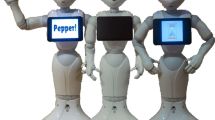Abstract
During an unannounced encounter, we study the appreciation of the robot’s sociable character (measured via the answers to a questionnaire) and the motion (arm and head movement frequency and smoothness using IMU sensors) of two humans interacting with a proactive humanoid, knowing that the experiment involves twenty pairs of participants. We also investigate the dependencies between the participants’ response to the robot’s non-verbal actions and their perception of its sociability. Our results show that the more the humans find the robot sociable, the more they tend to respond to its engaging gestures and the higher is the frequency of their arm motion and the smoothness of their head motion when interacting with it. Therefore, these results show that measurable physical movements might be significant indicators to investigate a social robot’s sociable character from the human partner’s point of view, as well as to possibly infer the human tendency to interact with it. More generally, the sociable trait attributed to an assistive robot operating in a public or in a private environment, seems to be one of the keys to the success of human-robot interactions.

Similar content being viewed by others
Abbreviations
- IMU:
-
Inertial measurement units
- HRI :
-
Human-robot interaction
References
Kim A, Han J, Jung Y, Lee K (2013) The effects of familiarity and robot gesture on user acceptance of information. In: 8th ACM/IEEE Int conf on human-robot interaction, 159–160
Salem M, Eyssel F, Rohlfing K, Kopp S, Joublin F (2013) To err is human(-like): effects of robot gesture on perceived anthropomorphism and likability. Int J Soc Robot 5(3):313–323
Sabelli AM, Kanta T, Hagita N (2011) A conversational robot in an elderly care center, an ethnographic study. In: Int conf on human-robot interaction, 37–44
Gillespie DL, Leffler A (1983) Theories of non-verbal behavior: a critical review of proxemics research. Sociol Theory 1:120–154
Firth R (1972) Verbal and bodily rituals of greeting and parting. The interpretation of ritual. Tavistock, London, pp 1–38
Kanda T, Ishiguro H, Imai M, Ono T (2004) Development and evaluation of interactive humanoid robots. Proc IEEE 92(11):1839–1850
Castellano G, Villaba S, Camurri A (2007) Recognising human emotions from body movement and gesture dynamics. In: Proceedings of the affective computing and intelligent interaction, 2nd international conference, ACII 2007. Springer-Verlag, Lisbon, Berlin, 71–82
Dael N, Goudbeek M, Scherer KR (2013) Perceived gesture dynamics in nonverbal expression of motion. Perception 42:642–657
Harrigan JA (2005) Proxemics, kinesics, and gaze. In: Harrigan JR, Rosenthal R, Scherer KR (eds) The new handbook of methods in nonverbal behavior research. Oxford University Press, Oxford, pp 137–198
Zhang R, Wang SH, Chen X, Yin D, Chen SH, Cheng M et al. (2011) Towards robot incremental learning constraints from comparative demonstration. In: Proceedings of 10th international conference on autonomous agents and multiagent systems (AAMAS 2011), 1301–1302
Scherer KR, Wallbott HG (1990) Ausdruck von emotionen. In: Scherer KR (ed) Enzyklopädie der Psychologie/Band Emotion. Hogrefe, Gottingen, pp 345–422
McColl D, Nejat G (2013) Recognizing emotional body language displayed by a human-like social robot. Int J Soc Robot 5(2):171–191
Wallbott HG (1998) Bodily expression of emotion. Eur J Soc Psychol 28:879–896
Boone RT, Cunningham JG (1998) Children’s decoding of emotion in expressive body movement: the development of cue attunement. Dev Psychol 34:1007–1016
Baddoura R, Matuskata R, Venture G (2012) The familiar as a key-concept in regulating the social and affective dimensions of HRI. In: Proceedings of the IEEE/RAS international conference on humanoid robots, 234–241
Kanda T, Ishiguro H, Imai M, Ono T (2003) Body movement analysis of human-robot interaction. In: Proceedings of the 18th international joint conference on artificial intelligence, 177–182
Baddoura R, Venture G (2013) Social versus useful HRI: experiencing the familiar, perceiving the robot as a sociable partner and responding to its actions. Int J Soc Robot 5(4):529–547
Rohrer B, Fasoli S, Krebs H, Hughes R, Volpe B, Frontera W, Stein J, Hogan N (2002) Movement smoothness changes during stroke recovery. J Neurosci 22(18):8297–8304
Powers A, Kiesler S (2006) The advisor robot: Tracing people’s mental model from a robot’s physical attributes. In: Proceedings of the conference on human-robot interaction, 218–225
Eyssel F, Hegel F, Horstman G, Wagner C (2010) Anthropomorphic inferences from emotional nonverbal cues: a case study. In: Proceedings IEEE international symposium on robot and human interactive communication, 681–686
Sabanovic S, Michalowski MP, Simmons Reid (2006) Robots in the wild: observing human-robot social interaction outside the lab. In: Proceedings of the IEEE international workshop on advanced motion control, 596–601
Acknowledgments
The authors acknowledge the support provided by the ”Women’s Future Development Organization”, Japan.
Author information
Authors and Affiliations
Corresponding author
Rights and permissions
About this article
Cite this article
Baddoura, R., Venture, G. This Robot is Sociable: Close-up on the Gestures and Measured Motion of a Human Responding to a Proactive Robot. Int J of Soc Robotics 7, 489–496 (2015). https://doi.org/10.1007/s12369-015-0279-x
Accepted:
Published:
Issue Date:
DOI: https://doi.org/10.1007/s12369-015-0279-x




